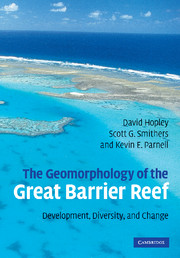Book contents
- Frontmatter
- Contents
- Preface
- Acknowledgements
- 1 Geomorphology and the Great Barrier Reef
- 2 Foundations of the Great Barrier Reef
- 3 Sea level: a primary control of long-term reef growth and geomorphological development
- 4 Oceanography, hydrodynamics, climate, and water quality as influences on reef geomorphological processes
- 5 Spatial analysis of the morphology of the reefs and islands of the Great Barrier Reef
- 6 The non-reefal areas of the continental shelf
- 7 Fringing and nearshore coral reefs
- 8 The mid-shelf reefs of the Great Barrier Reef
- 9 The coral reefs of the outer shelf of the Great Barrier Reef
- 10 Islands of the Great Barrier Reef
- 11 The accumulation of the Holocene veneer to the Great Barrier Reef
- 12 The Holocene evolution of the Great Barrier Reef province
- 13 Geomorphology's contribution to the understanding and resolution of environmental problems of the Great Barrier Reef
- References
- Geographic index
- Subject index
12 - The Holocene evolution of the Great Barrier Reef province
Published online by Cambridge University Press: 22 August 2009
- Frontmatter
- Contents
- Preface
- Acknowledgements
- 1 Geomorphology and the Great Barrier Reef
- 2 Foundations of the Great Barrier Reef
- 3 Sea level: a primary control of long-term reef growth and geomorphological development
- 4 Oceanography, hydrodynamics, climate, and water quality as influences on reef geomorphological processes
- 5 Spatial analysis of the morphology of the reefs and islands of the Great Barrier Reef
- 6 The non-reefal areas of the continental shelf
- 7 Fringing and nearshore coral reefs
- 8 The mid-shelf reefs of the Great Barrier Reef
- 9 The coral reefs of the outer shelf of the Great Barrier Reef
- 10 Islands of the Great Barrier Reef
- 11 The accumulation of the Holocene veneer to the Great Barrier Reef
- 12 The Holocene evolution of the Great Barrier Reef province
- 13 Geomorphology's contribution to the understanding and resolution of environmental problems of the Great Barrier Reef
- References
- Geographic index
- Subject index
Summary
Introduction
In previous chapters the characteristics and development of different sectors of the Great Barrier Reef (GBR) have been discussed largely on a spatial division – inter-reef shelf (Chapter 6), fringing and nearshore reefs (Chapter 7), mid-shelf reefs (Chapter 8), shelf-edge reefs (Chapter 9), and reef islands (Chapter 10). Chapter 11 derived rates of process from the data of previous chapters and provided some of the basics of the chronological framework used in this chapter, which attempts to provide a holistic rather than sectorial evolution of the GBR. Different processes clearly will be occurring simultaneously on different parts of the reef which may interact with each other. The driving force for the development of the reef, and the coast and shelf in general has been the postglacial rise in sea level, the basics of which were established in Chapter 3. This chapter looks at the changing geomorphology as sea level rose from its absolute low of about − 125 m 20 000 years ago at what are regarded as critical stages in the transgression. Initially sea level rose against a steeply sloping shoreline. Subsequently the antecedent Pleistocene reefs of the outer shelf became limestone islands before becoming submerged and developing their Holocene veneer. A completely different geomorphology existed on what is now the wide gently sloping shelf between the outer reef and mainland. Rates of shoreline change were rapid until the stillstand of the last 6.5 ka.
- Type
- Chapter
- Information
- The Geomorphology of the Great Barrier ReefDevelopment, Diversity and Change, pp. 411 - 430Publisher: Cambridge University PressPrint publication year: 2007



